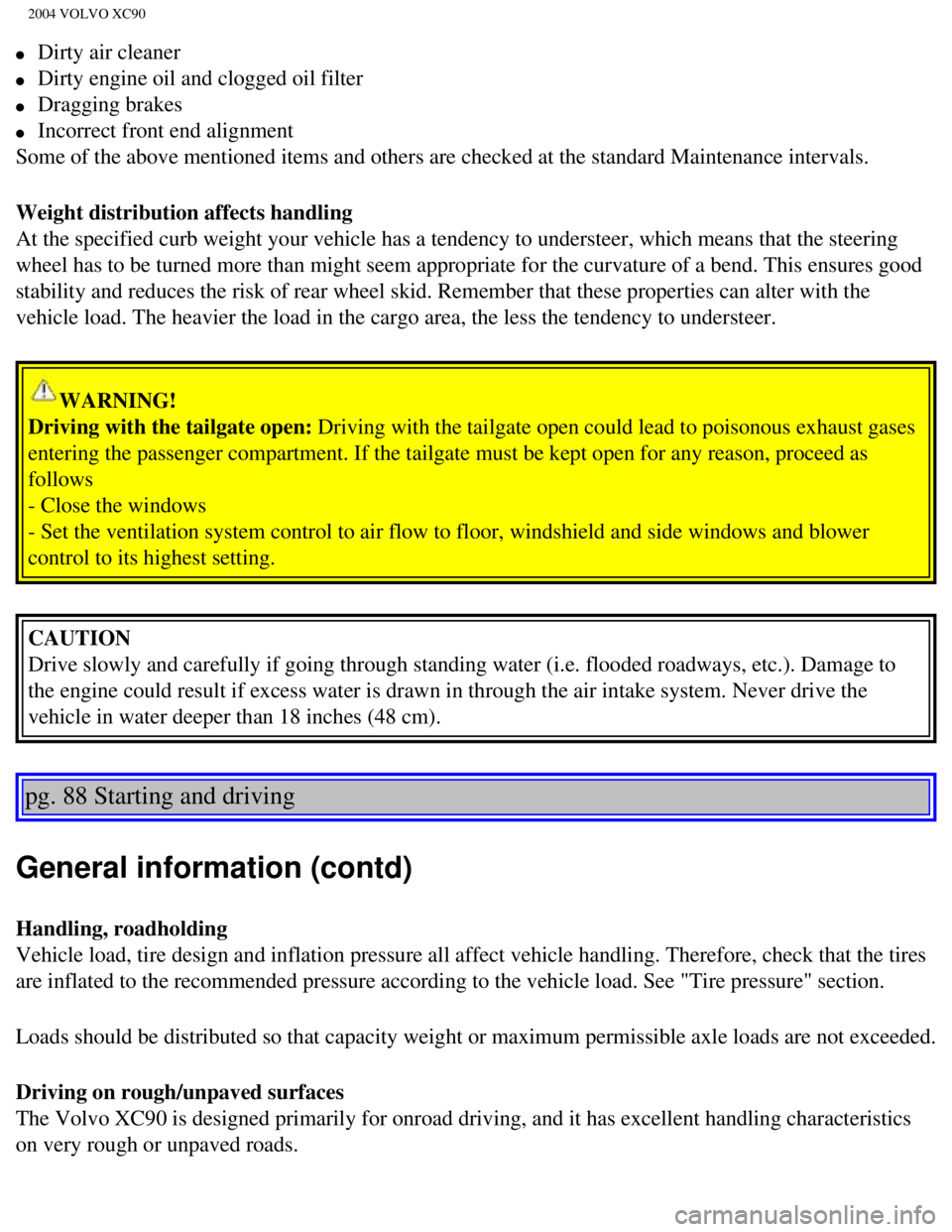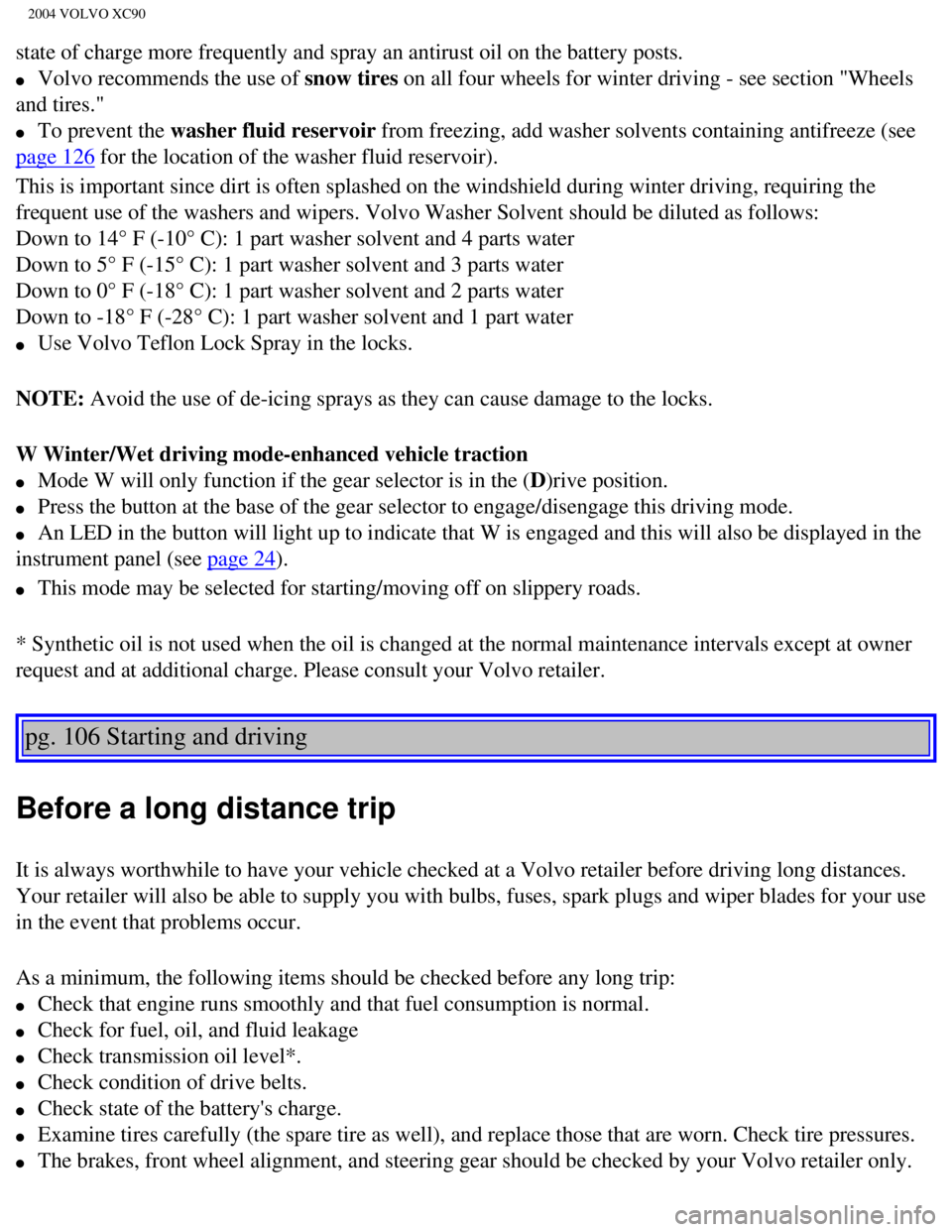Page 115 of 245

2004 VOLVO XC90
l Dirty air cleaner
l Dirty engine oil and clogged oil filter
l Dragging brakes
l Incorrect front end alignment
Some of the above mentioned items and others are checked at the standard\
Maintenance intervals.
Weight distribution affects handling
At the specified curb weight your vehicle has a tendency to understeer, \
which means that the steering
wheel has to be turned more than might seem appropriate for the curvatur\
e of a bend. This ensures good
stability and reduces the risk of rear wheel skid. Remember that these p\
roperties can alter with the
vehicle load. The heavier the load in the cargo area, the less the tende\
ncy to understeer.
WARNING!
Driving with the tailgate open: Driving with the tailgate open could lead to poisonous exhaust gases
entering the passenger compartment. If the tailgate must be kept open fo\
r any reason, proceed as
follows
- Close the windows
- Set the ventilation system control to air flow to floor, windshield an\
d side windows and blower
control to its highest setting.
CAUTION
Drive slowly and carefully if going through standing water (i.e. floode\
d roadways, etc.). Damage to
the engine could result if excess water is drawn in through the air inta\
ke system. Never drive the
vehicle in water deeper than 18 inches (48 cm).
pg. 88 Starting and driving
General information (contd)
Handling, roadholding
Vehicle load, tire design and inflation pressure all affect vehicle hand\
ling. Therefore, check that the tires
are inflated to the recommended pressure according to the vehicle load. \
See "Tire pressure" section.
Loads should be distributed so that capacity weight or maximum permissib\
le axle loads are not exceeded.
Driving on rough/unpaved surfaces
The Volvo XC90 is designed primarily for onroad driving, and it has exce\
llent handling characteristics
on very rough or unpaved roads.
file:///K|/ownersdocs/2004/2004_XC90/04xc90_06a.htm (9 of 15)12/30/200\
6 4:35:22 PM
Page 137 of 245

2004 VOLVO XC90
state of charge more frequently and spray an antirust oil on the battery\
posts.
l Volvo recommends the use of snow tires on all four wheels for winter driving - see section "Wheels
and tires."
l To prevent the washer fluid reservoir from freezing, add washer solvents containing antifreeze (see
page 126 for the location of the washer fluid reservoir).
This is important since dirt is often splashed on the windshield during \
winter driving, requiring the
frequent use of the washers and wipers. Volvo Washer Solvent should be d\
iluted as follows:
Down to 14° F (-10° C): 1 part washer solvent and 4 parts water \
Down to 5° F (-15° C): 1 part washer solvent and 3 parts water
Down to 0° F (-18° C): 1 part washer solvent and 2 parts water
Down to -18° F (-28° C): 1 part washer solvent and 1 part water \
l Use Volvo Teflon Lock Spray in the locks.
NOTE: Avoid the use of de-icing sprays as they can cause damage to the locks.
W Winter/Wet driving mode-enhanced vehicle traction
l Mode W will only function if the gear selector is in the (D)rive position.
l Press the button at the base of the gear selector to engage/disengage th\
is driving mode.
l An LED in the button will light up to indicate that W is engaged and thi\
s will also be displayed in the
instrument panel (see
page 24).
l This mode may be selected for starting/moving off on slippery roads.
* Synthetic oil is not used when the oil is changed at the normal mainte\
nance intervals except at owner
request and at additional charge. Please consult your Volvo retailer.
pg. 106 Starting and driving
Before a long distance trip
It is always worthwhile to have your vehicle checked at a Volvo retailer\
before driving long distances.
Your retailer will also be able to supply you with bulbs, fuses, spark p\
lugs and wiper blades for your use
in the event that problems occur.
As a minimum, the following items should be checked before any long trip\
:
l Check that engine runs smoothly and that fuel consumption is normal.
l Check for fuel, oil, and fluid leakage
l Check transmission oil level*.
l Check condition of drive belts.
l Check state of the battery's charge.
l Examine tires carefully (the spare tire as well), and replace those th\
at are worn. Check tire pressures.
l The brakes, front wheel alignment, and steering gear should be checked b\
y your Volvo retailer only.
file:///K|/ownersdocs/2004/2004_XC90/04xc90_06b.htm (16 of 17)12/30/20\
06 4:35:23 PM
Page 145 of 245

2004 VOLVO XC90
road holding on slippery surfaces than tires without the "all-season" ra\
ting.
However, for optimum road holding on icy or snow-covered roads, we recom\
mend suitable winter tires
on all four wheels. When replacing tires, be sure that the new tires are\
the same size designation, type
(radial) and preferably from the same manufacturer, on all four wheels\
. Otherwise there is a risk of
altering the vehicle's roadholding and handling characteristics.
NOTE: When storing wheel/tire assemblies (e.g. winter tires and wheels), eit\
her stand the assemblies
upright, or suspend them off the ground. Laying wheel/tire assemblies on\
their sides for prolonged
periods can cause wheel and/or tire damage.
New tires
Remember that tires are perishable goods. As of 2000, manufacturing year\
and week will be indicated
with 4 digits (e.g. 1502 means that the tire is manufactured year 2002,\
week 15).
Improving tire economy:
l Maintain correct tire pressure. See the tire pressure label on the insid\
e of the fuel filler door.
l Drive smoothly: avoid fast starts, hard braking and tire screeching.
l Tire wear increases with speed.
l Correct front wheel alignment is very important.
l Unbalanced wheels impair tire economy and driving comfort.
l If tires are rotated, they must be kept on the same side of the vehicle \
so that they revolve in the same
direction as before rotation.
l Hitting curbs or potholes can damage the tires and/or wheels permanently\
.
Flat spots
All tires become warm during use. After cooling, when the vehicle is par\
ked, the tires have a tendency to
distort slightly, forming flat spots. These flat spots can cause vibrati\
ons similar to the vibrations caused
by unbalanced wheels. They do, however, disappear when the tire warms up\
. The degree to which flat
spots form depends on the type of cord used in the tire. In cold weather\
, it takes longer for the tire to
warm up and consequently longer for the flat spot to disappear.
file:///K|/ownersdocs/2004/2004_XC90/04xc90_08.htm (2 of 13)12/30/2006\
4:35:25 PM